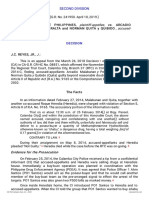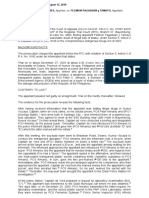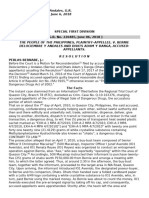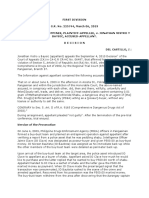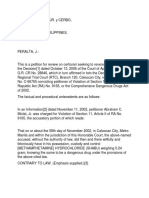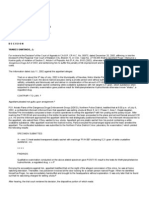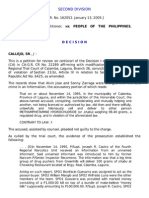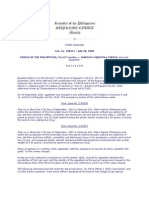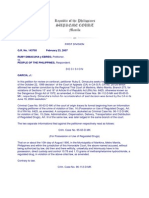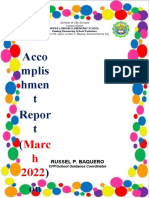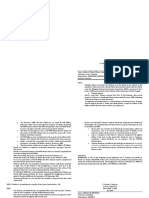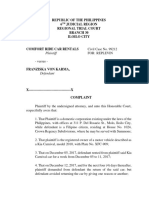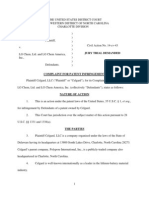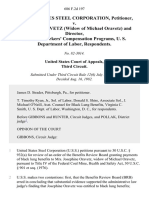Sample Case-People vs. Anson (G.R. No. 175940)
Sample Case-People vs. Anson (G.R. No. 175940)
Uploaded by
Aaron BeasleyCopyright:
Available Formats
Sample Case-People vs. Anson (G.R. No. 175940)
Sample Case-People vs. Anson (G.R. No. 175940)
Uploaded by
Aaron BeasleyOriginal Description:
Original Title
Copyright
Available Formats
Share this document
Did you find this document useful?
Is this content inappropriate?
Copyright:
Available Formats
Sample Case-People vs. Anson (G.R. No. 175940)
Sample Case-People vs. Anson (G.R. No. 175940)
Uploaded by
Aaron BeasleyCopyright:
Available Formats
G.R. No. 175940 February 6, 2008 [Formerly G.R. Nos. 155361-62] THE PEOPLE OF THE PHILIPPINES, appellee, vs.
ANSON ONG a.k.a. ALLAN CO, appellant. DECISION TINGA, J.: In dubio pro reo.1 Subject of this automatic review is the Decision2 of the Court of Appeals dated 7 August 2006 which affirmed the Judgment3 of the Regional Trial Court of Pasay City, Branch 110, convicting appellant Anson Ong alias Allan Co of illegal sale and possession of shabu. Two separate Informations were filed before the trial court. In Criminal Case No. 97-0017, appellant was accused of illegal sale of shabu, thus: That on or about the 21st day of [April] 1997, in Pasay City, Metro Manila, Philippines, and within the jurisdiction of this Honorable Court, the above-named accused, conspiring and confederating together and mutually helping one another without authority of law, did then and there willfully, unlawfully and feloniously sell and deliver 989.05 grams of Methamphetamine Hydrochloride (shabu), a regulated drug. Contrary to law.4 In Criminal Case No. 97-0018, appellant was charged with illegal possession of shabu allegedly committed as follows: That on or about the 21st day of April 1997, Pasay City, Metro Manila, Philippines, and within the jurisdiction of this Honorable Court, the above-named accused, Anson Ong alias "Allan Co," did then and there willfully, unlawfully and feloniously have in his possession, custody and control 988.85 grams of Methamphetamine Hydrochloride (shabu), a regulated drug without the corresponding license. Contrary to law.5 Upon arraignment, appellant pleaded not guilty to both charges. A joint trial of the two cases ensued.
The operative facts are narrated by prosecution witnesses who comprised members of the buy-bust team. Sometime in April 1997, Col. Zoila Lachica (Lachica) was tipped off by a female walk-in informant that a group, led by a Chinese national, was engaged in drug trafficking in Pasay City. Upon verification of said information, a meeting took place between Lachica and the informant where the latter was able to arrange a drug deal with appellant in the vicinity of Heritage Hotel.6 Lachica then instructed Investigator Oscar Coballes (Coballes) to prepare the boodle money consisting of four P500.00 bills and five P100.00 bills placed on top of nine (9) bundles of paper cut to the size of the peso bills. These bills were then submitted to the PNP Crime Laboratory for ultraviolet powder dusting.7 Before lunchtime on 21 April 1997, Lachica organized a team and planned the conduct of a buy-bust operation. The twelve-man team was composed of Lachica, Coballes, Police Supt. Edgar Danao (Danao), P/Inspector Rolando Montes (Montes), PO3 Manuelito Lagradilla (Lagradilla), SPO2 Wilfredo Saballa (Saballa), SPO3 Pardo, SPO2 Pedro Tan, the confidential informant, and other civilian agents. Danao acted as the team leader with Montes assisting him. Saballa was designated as the poseur-buyer and the other members of the team were tasked to secure the area.8 After lunch, the group proceeded to the parking lot of San Juan de Dios Hospital onboard four (4) vehicles, including a motorcycle driven by Lagradilla. At about 3:00 p.m., they reached the parking lot where Danao conducted the final briefing and then deployed his men strategically between the premises of Heritage Hotel and Copacabana Hotel.9 At 4:00 pm, Saballa and the informant went to Heritage Hotel while the other team members strategically posted themselves within the hotel premises.10 Fifteen minutes later, Saballa and the informant left Heritage Hotel and proceeded to the adjacent Copacabana Hotel where he waited at the main entrance of the lobby. Suddenly, a black Honda Civic car with Plate No. ULN 766 arrived and parked along the driveway near the front entrance.11 The informant approached the car while Saballa was left behind holding the black bag containing the boodle money.12 Upon signal by the informant, Saballa came up to the right front door. Saballa showed the contents of the bag to the driver of the car, who was later identified as appellant. He then handed the bag to him.13 Instantaneously, a man approached the car, took the boodle money from appellant and ran away.14 Coballes ran towards the drivers side and poked his gun at appellant. Appellant tried moving the car but Coballes stood in front and blocked it. Appellant was then ordered to open the door. Coballes saw a red bag containing white crystalline substance inside the car and took it into custody. 15Meanwhile, Lagradilla chased the man who took the boodle money around the parking area of Copacabana Hotel.16 While on the run, Lagradilla saw the man throw the money inside a passing white Toyota car driven by a certain Chito Cua (Cua). Instead of pursuing the man, Lagradilla blocked the white Toyota car and arrested Cua.17 Appellant presented an entirely different account of the incident on 21 April 1997. Appellant, who apparently does not know English and Tagalog was assisted by an interpreter, narrated that he is a resident of Chuan Chow, Peoples Republic of China. Upon the suggestion of Lau Chan, appellant decided to go to the Philippines to start a clothing business. In the morning of 21 April 1997, appellant told Lau Chan that he wanted to go to Baclaran. Lau Chan, who himself was planning to go to the casino at Heritage Hotel, asked appellant to meet up with him. Appellant tried calling Lau Chan on this cellphone but the latter was not answering. This prompted appellant to go to Heritage Hotel to look for Lau Chan. At around 4:00 p.m., appellant was walking along Epifanio Delos Santos Avenue towards the direction of the Light Rail Transit when he noticed a commotion in front of the hotel and saw some men carrying guns. Fearing for his safety, appellant decided to walk faster but someone stopped him and poked a gun at him. He was made to board a white car in which he met Cua for the first time. They were then brought to Camp Crame for questioning. It was Cua who translated the questions propounded by the police officers to appellant. He was informed by Cua that he was arrested for failure to show any document regarding his stay in the country. During arraignment however, he learned that he was being charged of possession and sale ofshabu.
Finding the testimonies of the prosecution witnesses credible as against the bare and self-serving assertions of appellant, the trial court rendered a decision finding appellant guilty as charged. The dispositive portion of the 11 February 2002 Decision reads: WHEREFORE, in view of the foregoing, the Court finds the herein accused ONG POK PIW a.k.a. ANSON ONG a.k.a. ALLAN CO, GUILTY beyond reasonable doubt of two (2) offenses for Violations of Section 15 and 16, Article III of Republic Act [No.] 6425, as amended in relation to Section 20 and 21 of Article IV of said law and hereby imposes on him the penalty of two (2) RECLUSION PERPETUAS in these cases and a fine in the total amount of P200,000.00 in these cases without subsidiary imprisonment in case of insolvency. The Methamphetamine Hydrochloride or "shabu" in Criminal Case No. 97-0017 for Violation of Section 15 of Republic Act [No.] 6425, as amended, weighing 989.05 grams and the Methamphetamine Hydrochloride or "shabu" in Criminal Case No. 97-0018 weighing 988.85 grams are hereby declared confiscated in favor of the government. The PNP Crime Laboratory at Camp Crame, Quezon City or its duly authorized representative which has custody and possession of said regulated drugs are hereby directed to immediately cause the delivery and transportation thereof to the Dangerous Drugs Board for proper disposition in accordance with law. The Chief of said office is further directed to inform this Court within 20 days from receipt hereof of the action taken thereon. The period during which the herein accused was under detention during the pendency of these cases shall be credited to him in full provided he agreed to abide by strictly with the rules and regulations of the City Jail. SO ORDERED.18 An appeal was directed to this Court. However, in a Resolution19dated 20 February 2006, the case was transferred to the Court of Appeals in light of our pronouncement in People v. Mateo.20 On 7 August 2006, the Court of Appeals rendered the assailed decision affirming with modification the trial courts ruling, to wit: WHEREFORE, premises considered, the judgment rendered by the Regional Trial Court, Branch 110, Pasay City, in Criminal Case Nos. 97-0017 and 97-0018 is hereby AFFIRMED with modification. As modified, the fine is increased to Five Hundred Thousand Pesos (P500,000.00) for each offense or a total of ONE MILLION PESOS (P1,000,000.00). SO ORDERED.21 In finding appellant guilty, the appellate court strongly relied on the testimonies of the police officers and dismissed the imputed inconsistencies in their statements as being minor. At the core of this appeal is the issue of whether the prosecution was able to prove beyond reasonable doubt the guilt of appellant. Appellant primarily questions the credibility of the prosecution witnesses. He claims that their testimonies were tainted with inconsistencies which even the trial court had noted in its decision. Appellant relies on said observation to support his acquittal based on reasonable doubt. He asserts that his conviction must rest on the strength of the prosecutions own evidence and not on the weakness of the evidence for the defense.
The Office of the Solicitor General (OSG), in its Brief,22 insists that all the elements of sale and illegal possession of shabu were duly established by the prosecution. It avers that appellant was caught in flagrante delicto sellingshabu to the poseur-buyer in a legitimate buy-bust operation.23 Moreover, when the poseur-buyer and Coballes opened the door of appellants car, they saw a red bag on the floor containing white crystalline substances which were later tested and found positive for the presence of shabu.24 The OSG contends that the opinion of the trial court with respect to the actuations of the prosecution witnesses on the stand did not affect its judgment of conviction because the trial court lent full faith and credence to the collective testimonies of the police officers who are presumed to have performed their duties in accordance with law.25 For the prosecution of illegal sale of drugs to prosper, the following elements must be proved: (1) the identity of the buyer and seller, the object, and the consideration; and (2) the delivery of the thing sold and the payment therefor. What is material is the proof that the transaction actually took place, coupled with the presentation before the court of the corpus delicti.26 The prosecution seeks to establish the presence of these elements through the testimonies of the police officers involved in the buy-bust operation. The innocence or culpability of appellant thus hinges on the issue of credibility. It is an oft-repeated rule that findings of facts of the trial court, as affirmed by the appellate court, are conclusive on this Court, absent any evidence that both courts ignored, misconstrued, or misinterpreted cogent facts and circumstances of substance which, if considered, would warrant a modification or reversal of the outcome of the case.27 This case falls under the exception. In determining the credibility of prosecution witnesses regarding the conduct of buy-bust operation, the "objective test," as laid down in People v. Doria,28 is utilized. It has been held that it is the duty of the prosecution to present a complete picture detailing the buy-bust operationfrom the initial contact between the poseur-buyer and the pusher, the offer to purchase, the promise or payment of the consideration, until the consummation of the sale by the delivery of the illegal subject of sale. The manner by which the initial contact was made, the offer to purchase the drug, the payment of the buy-bust money, and the delivery of the illegal drug must be the subject of strict scrutiny by courts to insure that law-abiding citizens are not unlawfully induced to commit an offense.29 In People v. Ong30 and Cabugao v. People31 where the "objective test" was also applied, chasmic deficiencies that similarly marked the prosecution evidence led to the absolution of the accused. In Ong, also involving Chinese nationals as accused, the prosecution evidence on the buy-bust operation was outrageously complete as the confidential informant who had sole knowledge of how the alleged illegal sale of shabu was initiated and how it was carried out was not presented as a witness.32 In Cabugao, the prosecution witnesses could not agree on the reason that prompted them to conduct the buy-bust operation. While the first witness testified that the tip came from their informants, the second witness maintained that no informer was involved in the operation.33 In the case at bar, the evidence for the prosecution failed to prove all the material details of the buybust operation. The details of the meeting with the informant, the alleged source of the information on the sale of illegal drugs, appear hazy. Lachica declared that he met the informant for the first time a week before the buy-bust operation: Q Do you recall Mr. Witness when that walk-in informant visited your office?
A I cannot recall the exact date but as far as I can remember she visited before the operation was conducted. FISCAL
And you are referring to the operation on April 21, 1997? A Yes, sir.
COURT How many days prior to the date of operation did that alleged walk-in informant go to your office? A I cannot remember the exact date but I think more or less one week before. More or less 1 week.34 But Coballes testified that the informant reports to their office every now and then, thus: COURT A moment counsel, this informant, was he an employee of your office or an informant working for your office? WITNESS A He is an informant working from our office.
COURT When you say informant working in your office, is he receiving salary from your office as a regular employee or he reports or he goes to your office every now and then? A He reports in our office every now and then.35
Coballes related that the informant was present during the briefing held before lunch on 21 April 1997: Q Now when Col. Lachica called you, aside from you and some members of your office, are there any other persons present? A Q A Yes sir, our informant. Now how do you know that this person is an informant? He was introduced to us by our chief, Col. Lachic[a], sir.36
while Lagradilla denied seeing the informant at the meeting: COURT In that briefing, was there a mention of an informant or an asset? WITNESS
Col. Lachica mentioned of a certain asset.
COURT Was that asset present during the briefing at the headquarters? A Asset was not present[,] sir.37
Despite being the designated poseur-buyer, Saballa testified that he had no knowledge of how much shabu he was going to buy. Q A Q A Q A How much shabu are you going to purchase? One (1) kilo, Your Honor. How much is one kilo worth? I am not aware of the price, Your Honor. How much is one kilo worth? I do not know the price they have agreed, Your Honor.
Q You are supposed to be the poseur buyer and you do not know how much shabu you are going to buy? A I do not know, Your Honor.38
The actual exchange of the bags containing shabu and the boodle money was not clearly established. The presentation of shabu before the Court could have shed light on the identity of the object of the sale. Unfortunately, the presentation of the shabu purportedly confiscated from appellant was dispensed with at the instance of the defense counsel.39 Coballes testified that he saw Saballa hand the boodle money to appellant in exchange for a wrapped object presumed to be shabu.40 On the contrary, the ultraviolet dusting of the boodle money was conducted but appellant was found negative for fluorescent powder. 41 As between the prosecution witnesses account that it was appellant to whom the boodle money was passed and who was driving the black Honda Civic car during the alleged buy-bust operation and appellants denial that he owned and drove said car, we are inclined to believe appellant. The prosecution failed to present the purported drivers license confiscated from appellant. In fact, they reasoned that it was missing.42 On the other hand, the defense presented a certification from the Land Transportation Office (LTO) and the Philippine Motor Association stating that appellants name does not exist in the LTOs file of licensed drivers and has not been issued a Philippine International Driving Permit43 by the Automobile Association of the Philippines. Further rendering the prosecutions version dubious is the escape of another alleged cohort of appellant. Lagradilla, who was specifically tasked to block or run after any escaping suspect, failed in this regard. During the alleged buy-bust operation, he was positioned in such a manner that a firewall was blocking his vantage point.44Instead of using his motorcycle, he chased the suspect on
foot.45 Moreover, it is quite difficult to imagine how one suspect can easily escape notwithstanding the presence of at least twelve (12) police operatives in the vicinity. The witnesses hesitation in answering questions on the stand, as aptly observed by the trial court,46 only compounded their lack of credibility. Lachica, who was the Chief of the Criminal Investigation Division of the NCR-CIDG, cannot seem to recall the vital parts of the buy-bust operation such as the composition of the buy-bust team, the strategic location of the team members, the presence of the name of the other accused, Cua,47 and how much of the boodle money was recovered.48 Moreover, he denied any participation in the conduct of the buy-bust operation: Q You said you supervised the planning of this operation. Did you not say that?
A No Your Honor[,] what I said is that I gave instruction to Col. Danao and we planned out the operation and our procedure, the [over-all] team leader will be the one to provide or make some arrangement[s] pertaining to the police operation.49 However, Coballes insisted that Lachica was present all throughout the operation, thus: ATTY. ZULUETA And so, in your testimony February 13, 2000[,] you narrated to the Court that Col. Lachica led this operation? A Q A Q A Q A Yes, sir. He was with you on the parking lot to brief you on your operation? Yes. And he was with you all throughout the operation? He was at the Heritage Hotel. Yes. Mr. Witness[,] you as police officer[,] do you know the penalty for perjury? I know that perjury is punishable but I dont know the penalty.
Q Did you know that Col. Lachica appeared before this Court and testified in this Hon. Court on July 29, 1999 and he testified that he did not conduct the actual operation but it was Col. Danao? A Q He was with us and Col. Danao at the Heritage Hotel at the time. Will you still maintain that, who is lying now, Col. Lachica or you?
A Col. Lachica and the rest stayed at the Heritage Hotel considering that the buy-bust operation was at the Heritage Hotel.
Q And yet, Col. Lachica said that as lone Chief of the Criminal Investigation Division he only gave instruction to Col. Danao. The question is[:] do you still maintain despite that [sic] testimony that Col. Lachica was present during the operation? A I do.50
Lachica denied having heard of the name of appellant until he was arrested: Q A Q Will you tell the Court[,] do you know a certain Anson Ong alias Allan Co? During April? Before April?
A No, I dont remember that I encountered a name Anson Ong but after the operation conducted by Edgar Danao[,] I read the name of Anson Ong as the arrested person.51 On the other hand, Montes alleged that the name of appellant was mentioned during the briefing held in the office: FISCAL VIBANDOR Q Mr. Witness, on April 21, 1997, you said that you will conduct a buy-bust operation against whom? WITNESS A Against Anson Ong.
FISCAL VIBANDOR Q Now, when for the first time did you come to know that you are going to conduct [buybust] operation against Anson Ong? A During our briefing at the office.
xxx Q And who were present during that briefing?
A All of us except for Lagradilla because he was sent out to get his motor bike, it was only Col. Danao, myself, Coballes, Saballa, Tan and [a] civilian asset.52 According to Coballes, he was instructed by Lachica to prepare the boodle money to be submitted to the PNP Crime Laboratory for powder dusting: Q You want to impress us Mr. Witness, that a week or before the day that you first met the informant you were instructed by Colonel Lachica to prepare buy-bust money? WITNESS
Yes, sir.53
Lachicas million-peso estimate of the drug deal is certainly higher than the P250,000.00 amount stated by Coballes. Ironically, Lachica cannot recall the exact amount or denomination of the boodle money he himself had provided for the operation: Q According to you[,] there will be a drug deal. Do you know how much shabu is involved in this drug deal as arranged by your lady informant? A Q A I cannot recall the exact amount or quantity but the deal is more than one million. x x x54 Who provided the buy bust money for this buy-bust operation? I was the one who provided the buy-bust money, the boodle money.
FISCAL Q How much money did you provide?
A I cannot remember the exact amount because the money used in that operation is boodle money. Q A Q A And to whom did you give this money that will be used in this [buy-bust] operation? I think Agent Coballes. Do you recall in what denomination were these [buy-bust] money given? I cannot remember.55
While the presentation of the boodle money, as a general rule, is not indispensable in the prosecution of a drug case, the material inconsistencies in the testimonies of the prosecution witnesses and the non-presentation of the buy-bust money raise reasonable doubts on the occurrence of a buy-bust operation.56 It is indeed suspicious that vital pieces of evidence, such as the boodle money and the drivers license were lost while in the custody of Coballes who unfortunately passed away during trial. Certainly, the failure to present vital pieces of these evidence cast doubt on the veracity of the buy-bust operation. Another baffling point is the dismissal of the criminal case against Cua, the alleged accomplice of appellant. The prosecution witnesses testified that the boodle money was found in his possession. This fact was confirmed by the presence of fluorescent powder on Cuas hands. The Constitution mandates that an accused shall be presumed innocent until the contrary is proven beyond reasonable doubt. While appellants defense engenders suspicion that he probably perpetrated the crime charged, it is not sufficient for a conviction that the evidence establishe a strong suspicion or probability of guilt. It is the burden of the prosecution to overcome the presumption of innocence by presenting the quantum of evidence required. In the case at bar, the basis of acquittal is reasonable doubt, the evidence for the prosecution not being sufficient to sustain and prove the guilt of appellants with moral certainty. By reasonable doubt is not meant that which of possibility may arise but it is that doubt engendered by an investigation of
the whole proof and an inability, after such an investigation, to let the mind rest easy upon the certainty of guilt. An acquittal based on reasonable doubt will prosper even though the appellants' innocence may be doubted, for a criminal conviction rests on the strength of the evidence of the prosecution and not on the weakness of the evidence of the defense.57 Suffice it to say, a slightest doubt should be resolved in favor of the accused.58 With the failure of the prosecution to present a complete picture of the buy-bust operation, as highlighted by the disharmony and incoherence in the testimonies of its witnesses, acquittal becomes ineluctable. WHEREFORE, the Decision of the Court of Appeals in CA-G.R. CR-H.C. No. 02256 is REVERSED and SET ASIDE. Anson Ong a.k.a. "Allan Co" is ACQUITTED of the crime charged against him on the ground of reasonable doubt. His immediate release from prison is ordered unless he is being held for some other valid or lawful cause. The Director of the Bureau of Corrections is ORDERED to implement this Decision forthwith and to INFORM this Court, within five (5) days from receipt hereof, of the date appellant was actually released from confinement. Costsde oficio. SO ORDERED. Quisumbing,Chairperson, Carpio, Carpio-Morales, Velasco, Jr., JJ., concur.
Footnotes
1
This Latin legal maxim literally means "when in doubt, for the accused." The earliest historical root of this rule is from the Roman Emperor Trajan (AD 98-117) when he gave the legal advice that "it is better not to punish the act of a culprit than to sentence an innocent."
2
Rollo, pp. 3-24; penned by Associate Justice Normandie Pizarro and concurred in by Associate Justices Josefina Guevara-Salonga and Aurora Santiago-Lagman.
3
CA rollo, pp. 32-43; presided by Judge Porfirio G. Macaraeg. Id. at 13. Id. at 15. TSN, 29 July 1999, pp. 4-9. TSN, 3 March 1998, p. 13. Id. at 16-17. Id. at 17-20. Id. at 21-22.
10
11
TSN, 26 November 1999, p. 44. TSN, 3 March 1998, p. 30-34. TSN, 17 October 2000, pp. 44-47. TSN, 3 March 1998, pp. 36-37. Id. at 41-43. Id. at 40. TSN, 26 November 1999, p. 54. CA rollo, pp. 42-43. Rollo, p. 2. G.R. Nos. 147678-87, 7 July 2004, 433 SCRA 640. Rollo, p. 23. CA rollo, pp. 108-128. Id. at 118. Id. at 120. Id. at 123.
12
13
14
15
16
17
18
19
20
21
22
23
24
25
26
People v. Quiaoit, G.R. No. 175222, 27 July 2007; People v. Cabugatan, G.R. No. 172019, 12 February 2007, 515 SCRA 537, 547; People v. Del Mundo, G.R. No. 169141, 6 December 2006, 510 SCRA 554, 562.
27
People v. Dilao, G.R. No. 170359, 27 July 2007. 361 Phil. 595 (1999).
28
29
Cabugao v. People, G.R. No. 158033, 30 July 2004, 435 SCRA 624; People v. Ong, G.R. No. 137348, 21 June 2004, 432 SCRA 471, 485; People v. De Guzman, G.R. No. 151205, 9 June 2004, 431 SCRA 516, 523; People v. Padasin, 445 Phil. 448, 456 (2003).
30
G.R. No. 137348, 21 June 2004, 432 SCRA 471. G.R. No. 158033, 30 July 2004, 435 SCRA 624. Supra note 30. Supra note 31 at 634.
31
32
33
34
TSN, 29 July 1999, pp. 4-5. TSN, 14 December 1998, p. 19. TSN, 3 March 1998, p. 9. TSN, 26 November 1999, pp. 12-13. TSN, 17 October 2000, p. 18. TSN, 3 March 1998, p. 34. Id. TSN, 22 August 2000, p. 7. TSN, 12 February 1999, p. 3. Records, pp. 299-300. TSN, 26 November 1999, p. 48. Id. at 51. TSN, 29 July 1999, p. 8; 26 November 1999, p. 19. TSN, 29 July 1999, p. 18. Id. at 30. Id. TSN, 25 April 2000, p. 12. TSN, 29 July 1999, p. 4. TSN, 15 February 2000, pp. 7-8. TSN, 3 March 1998, pp. 12-13. TSN, 29 July 1999, p. 8. Id. at 14. People v. Balag-Ey, G.R. No. 141532, 14 April 2004, 427 SCRA 384, 406.
35
36
37
38
39
40
41
42
43
44
45
46
47
48
49
50
51
52
53
54
55
56
57
People v. Pabiona, G.R. No. 145803, 30 June 2004, 433 SCRA 301, 323, citing People v. Morada, 307 SCRA 362, 380 (1999), People v. Caete, G.R. No. 128321, 11 March 2004, 425 SCRA 353, and People v. Leao, 366 SCRA 774, 792 (2001).
58
People v. Milan, 370 Phil. 493, 506 (1999).
You might also like
- People Vs EdanoDocument3 pagesPeople Vs EdanoWresen Ann100% (1)
- Keng Hua Products v. CA (Digest)Document3 pagesKeng Hua Products v. CA (Digest)Dany AbuelNo ratings yet
- Appellee Vs Vs Appellant: Second DivisionDocument12 pagesAppellee Vs Vs Appellant: Second DivisionJeunice VillanuevaNo ratings yet
- People vs. Alfredo Reyes Feb. 18, 2015Document7 pagesPeople vs. Alfredo Reyes Feb. 18, 2015Jomai siomaiNo ratings yet
- January 19, 2018 G.R. No. 216017Document7 pagesJanuary 19, 2018 G.R. No. 216017Florena CayundaNo ratings yet
- People v. HamboraDocument6 pagesPeople v. HamboraHeersosNo ratings yet
- April 6, 2016 G.R. No. 206766 PEOPLE OF THE PHILIPPINES, Plaintiff-Appellee, EDUARDO YEPES, Accused-Appellant. Decision Perez, J.Document61 pagesApril 6, 2016 G.R. No. 206766 PEOPLE OF THE PHILIPPINES, Plaintiff-Appellee, EDUARDO YEPES, Accused-Appellant. Decision Perez, J.Iana CleoNo ratings yet
- Evidence Case Red InkedDocument49 pagesEvidence Case Red InkedLeonor LeonorNo ratings yet
- Memorandum (Eric Uy) Prac CourtDocument19 pagesMemorandum (Eric Uy) Prac CourtMc DalayapNo ratings yet
- People vs. CahilijiDocument4 pagesPeople vs. CahilijiSidrick GalecioNo ratings yet
- Crimproc CasesDocument35 pagesCrimproc CasesSharina Wee JayagNo ratings yet
- G.R. No. 176077 August 31, 2011 Abraham Miclat, JR. y CERBO, Petitioner, People of The Philippines, RespondentDocument59 pagesG.R. No. 176077 August 31, 2011 Abraham Miclat, JR. y CERBO, Petitioner, People of The Philippines, RespondentCecile FederizoNo ratings yet
- People V MalabananDocument10 pagesPeople V MalabananArjay ElnasNo ratings yet
- Evidence Final DigestDocument39 pagesEvidence Final DigestElle BanigoosNo ratings yet
- G.R. No. 206766Document6 pagesG.R. No. 206766Maria Jeminah TurarayNo ratings yet
- People - v. - Chi - Chan - LiuDocument15 pagesPeople - v. - Chi - Chan - LiuGerard TinampayNo ratings yet
- 636, G.R. No. 187157 People Vs ClariteDocument7 pages636, G.R. No. 187157 People Vs ClaritenazhNo ratings yet
- CRIMPRO Rule 126 CasesDocument44 pagesCRIMPRO Rule 126 CasesMarife Tubilag ManejaNo ratings yet
- Plaintiff and Appellee vs. vs. Accused-Appellant: Third DivisionDocument7 pagesPlaintiff and Appellee vs. vs. Accused-Appellant: Third DivisionamaedechavezNo ratings yet
- A2. People v. PagaduanDocument10 pagesA2. People v. PagaduanMarie ReloxNo ratings yet
- Appellee's Brief - PP v. BuybustDocument17 pagesAppellee's Brief - PP v. BuybustDennis GoNo ratings yet
- PB AffidavitDocument3 pagesPB Affidavitchristyngaloy1995No ratings yet
- Digested - People V Ansong OngDocument3 pagesDigested - People V Ansong OngDashiel TanNo ratings yet
- 9 People v. Pagaduan, 627 SCRA 308, G.R. No. 179029, August 9, 2010 (Chain of Custody Rule)Document8 pages9 People v. Pagaduan, 627 SCRA 308, G.R. No. 179029, August 9, 2010 (Chain of Custody Rule)EK ANGNo ratings yet
- People V Dumagay DigestDocument3 pagesPeople V Dumagay DigestMs JNo ratings yet
- Case StudyDocument21 pagesCase StudyKarl David CalaguiNo ratings yet
- First DivisionDocument12 pagesFirst DivisionMark Alconaba GeronimoNo ratings yet
- People v. Delociembre y Andales, G.R. No. 226485 (Resolution), June 6, 2018Document8 pagesPeople v. Delociembre y Andales, G.R. No. 226485 (Resolution), June 6, 2018Mary ruth DavidNo ratings yet
- People V Vistro 2019Document5 pagesPeople V Vistro 2019joselle torrechillaNo ratings yet
- Miclat Vs PeopleDocument17 pagesMiclat Vs PeopleElSalvadorNo ratings yet
- Drug Cases UnprintedDocument37 pagesDrug Cases UnprintedFrancis LagramaNo ratings yet
- The People of The Philippines v. Zaida Kamad y AmbingDocument6 pagesThe People of The Philippines v. Zaida Kamad y AmbingbearzhugNo ratings yet
- 3 People V EndayaDocument19 pages3 People V EndayaFrances Angelica Domini KoNo ratings yet
- E. Partially Valid WarrantDocument10 pagesE. Partially Valid WarrantsiddayaojanusNo ratings yet
- People V NG Yik BunDocument20 pagesPeople V NG Yik BunJuan Dela CruiseNo ratings yet
- People Vs Dela RosaDocument24 pagesPeople Vs Dela RosaShane Fernandez JardinicoNo ratings yet
- Plaintiff-Appellee Vs Vs y y Accused-Appellant: Second DivisionDocument13 pagesPlaintiff-Appellee Vs Vs y y Accused-Appellant: Second DivisionCYMON KAYLE LubangcoNo ratings yet
- Plaintiff-Appellee vs. vs. Accused-Appellant: Third DivisionDocument6 pagesPlaintiff-Appellee vs. vs. Accused-Appellant: Third DivisionamaedechavezNo ratings yet
- PP vs. Chi Chan LiuDocument12 pagesPP vs. Chi Chan LiuTia RicafortNo ratings yet
- Gutierrez, JR., J.:: The Office of The Solicitor General For Plaintiff-Appellee. Katz N. Tierra For Defendant-AppellantDocument5 pagesGutierrez, JR., J.:: The Office of The Solicitor General For Plaintiff-Appellee. Katz N. Tierra For Defendant-AppellantBenz Clyde Bordeos TolosaNo ratings yet
- Crim CaseDocument6 pagesCrim CasebchiefulNo ratings yet
- Crimanal Cases Compilation 3Document70 pagesCrimanal Cases Compilation 3Lex DagdagNo ratings yet
- Ra 9165Document25 pagesRa 9165Tots Subiate100% (1)
- G.R. No. L-63630 April 6, 1990 PEOPLE OF THE PHILIPPINES, Plaintiff-AppelleeDocument8 pagesG.R. No. L-63630 April 6, 1990 PEOPLE OF THE PHILIPPINES, Plaintiff-Appelleesunsetsailor85No ratings yet
- People Vs Edano DigestDocument2 pagesPeople Vs Edano DigestirvndgreatNo ratings yet
- Plaintiff-Appellee vs. vs. Accused-Appellant.: Third DivisionDocument15 pagesPlaintiff-Appellee vs. vs. Accused-Appellant.: Third DivisionamaedechavezNo ratings yet
- Appellee Appellant: People of The Philippines, - Wilson Suan Y JolongonDocument11 pagesAppellee Appellant: People of The Philippines, - Wilson Suan Y JolongonGina RothNo ratings yet
- Compilation of 2014 Drug CasesDocument340 pagesCompilation of 2014 Drug CasesChingkay Valente - JimenezNo ratings yet
- Third Division (G.R. No. 176077, August 31, 2011)Document11 pagesThird Division (G.R. No. 176077, August 31, 2011)JB AndesNo ratings yet
- People V TanglibenDocument7 pagesPeople V TanglibenSheila CorpuzNo ratings yet
- People of The Philippines, Carrera Imbat,: Shabu Bulto Bulto ShabuDocument3 pagesPeople of The Philippines, Carrera Imbat,: Shabu Bulto Bulto ShabuBab LyNo ratings yet
- Investigation ReportDocument5 pagesInvestigation Reportchristyngaloy1995No ratings yet
- People Vs BalibayDocument9 pagesPeople Vs BalibayFord OsipNo ratings yet
- Title 5 Dangerous DrugsDocument23 pagesTitle 5 Dangerous DrugsMarco MarianoNo ratings yet
- Enforcement of Fishing, Customs, and Immigration Laws - People V. Chi Chan LiuDocument13 pagesEnforcement of Fishing, Customs, and Immigration Laws - People V. Chi Chan LiuAngel CabanNo ratings yet
- Jose V PeopleDocument12 pagesJose V PeopleIrish GarciaNo ratings yet
- 21 San Juan Vs People May 30, 2011Document5 pages21 San Juan Vs People May 30, 2011Bryne BoishNo ratings yet
- Chain of CustodyDocument85 pagesChain of CustodyErnesto AbesamisNo ratings yet
- 004 People vs. HavanaDocument8 pages004 People vs. Havanast3ll4_my8No ratings yet
- Humanizing Immigration: How to Transform Our Racist and Unjust SystemFrom EverandHumanizing Immigration: How to Transform Our Racist and Unjust SystemNo ratings yet
- Election Prohibited ActsDocument35 pagesElection Prohibited ActsAaron BeasleyNo ratings yet
- People vs. Padua (G.R. No. 174097)Document9 pagesPeople vs. Padua (G.R. No. 174097)Aaron BeasleyNo ratings yet
- People vs. Pringas (G.R. No. 175928)Document13 pagesPeople vs. Pringas (G.R. No. 175928)Aaron BeasleyNo ratings yet
- R.A. 6735Document4 pagesR.A. 6735Aaron BeasleyNo ratings yet
- Sample Case-People vs. Chiu (G.R. Nos. 142915-16)Document11 pagesSample Case-People vs. Chiu (G.R. Nos. 142915-16)Aaron BeasleyNo ratings yet
- Sample Case-People vs. Naquita (G.R. No. 180511)Document16 pagesSample Case-People vs. Naquita (G.R. No. 180511)Aaron BeasleyNo ratings yet
- Sample CaseDocument12 pagesSample CaseAaron BeasleyNo ratings yet
- Sample Case - Dimacuha vs. People (G.R. No. 143705)Document11 pagesSample Case - Dimacuha vs. People (G.R. No. 143705)Aaron BeasleyNo ratings yet
- Duncan Assoc. of Detailman-PTGWO vs. Glaxo Wellcome Phils., Inc. (Digested)Document2 pagesDuncan Assoc. of Detailman-PTGWO vs. Glaxo Wellcome Phils., Inc. (Digested)Aaron BeasleyNo ratings yet
- Problem 1 AppellantDocument29 pagesProblem 1 AppellantShreya Ghosh Dastidar100% (1)
- Bengzon vs. The Secretary of JusticeDocument1 pageBengzon vs. The Secretary of JusticeKanraMendozaNo ratings yet
- 38 Tan vs. Municipality of PagbilaoDocument4 pages38 Tan vs. Municipality of PagbilaoSara Andrea SantiagoNo ratings yet
- Gabriel v. Pangilinan DigestDocument3 pagesGabriel v. Pangilinan DigestApple Lentejas - Quevedo100% (1)
- Almero vs. PeopleDocument7 pagesAlmero vs. PeopleBen OriondoNo ratings yet
- SpaceX Response DOJ Hiring SubpoenaDocument21 pagesSpaceX Response DOJ Hiring SubpoenaCNBC.comNo ratings yet
- Annexure I English Application Form - Technical AuditDocument4 pagesAnnexure I English Application Form - Technical Auditshiva shivaNo ratings yet
- Accomplishment-Report-on-CHILD-MARCH 2022Document3 pagesAccomplishment-Report-on-CHILD-MARCH 2022Russel PaghubasanNo ratings yet
- PENOLOGYDocument29 pagesPENOLOGYJohnpaul Bajan100% (1)
- Zainab CV PDFDocument3 pagesZainab CV PDFZainabNo ratings yet
- Shoemart Vs NLRCDocument6 pagesShoemart Vs NLRCMermerRectoNo ratings yet
- Tabuena CaseDocument18 pagesTabuena CaseJoshua LanzonNo ratings yet
- RipTide RFID 9500Document2 pagesRipTide RFID 9500Franz TermonNo ratings yet
- Peoria County Booking Sheet 06/08/13Document11 pagesPeoria County Booking Sheet 06/08/13Journal Star police documentsNo ratings yet
- Mmda Vs JancomDocument11 pagesMmda Vs JancomArthur YamatNo ratings yet
- Offer Letter - Mohammad AsiDocument16 pagesOffer Letter - Mohammad AsiRicha ruhelaNo ratings yet
- ReplevinDocument4 pagesReplevinJoshua Became A CatNo ratings yet
- Walker v. Donahoe, Et Al. Defendant's Motion in Limine To Exclude Portions of VideoDocument5 pagesWalker v. Donahoe, Et Al. Defendant's Motion in Limine To Exclude Portions of VideojhbryanNo ratings yet
- Apex Ultima Warranty GuideDocument4 pagesApex Ultima Warranty GuideGurumurthy SubramanianNo ratings yet
- Art. 1459 - 1465Document46 pagesArt. 1459 - 1465Noel Cagigas FelongcoNo ratings yet
- Radio Communications of The PhilippinesDocument2 pagesRadio Communications of The PhilippinesDonn TantuanNo ratings yet
- Celgard v. LG Chem Et. Al.Document14 pagesCelgard v. LG Chem Et. Al.PriorSmartNo ratings yet
- Appellee Brief: Prianka Bose v. Roberto Bea, Et AlDocument67 pagesAppellee Brief: Prianka Bose v. Roberto Bea, Et AlSouwesterdocs100% (1)
- 4 Law Assignment 1 Front Sheet 21042017Document13 pages4 Law Assignment 1 Front Sheet 21042017P. T. HiếuNo ratings yet
- Ethical, Social, and Political Issues in E-CommerceDocument25 pagesEthical, Social, and Political Issues in E-CommerceAlan PeakNo ratings yet
- Malabanan VS RepublicDocument2 pagesMalabanan VS RepublicKaren RonquilloNo ratings yet
- United States Steel Corporation v. Josephine Oravetz (Widow of Michael Oravetz) and Director, Office of Workers' Compensation Programs, U. S. Department of Labor, 686 F.2d 197, 3rd Cir. (1982)Document7 pagesUnited States Steel Corporation v. Josephine Oravetz (Widow of Michael Oravetz) and Director, Office of Workers' Compensation Programs, U. S. Department of Labor, 686 F.2d 197, 3rd Cir. (1982)Scribd Government DocsNo ratings yet
- Fundamentals of Criminal InvestigationDocument41 pagesFundamentals of Criminal InvestigationLycka R. MarcoNo ratings yet
- Upper Deerfield Police ShootingDocument50 pagesUpper Deerfield Police Shootingjalt61No ratings yet












